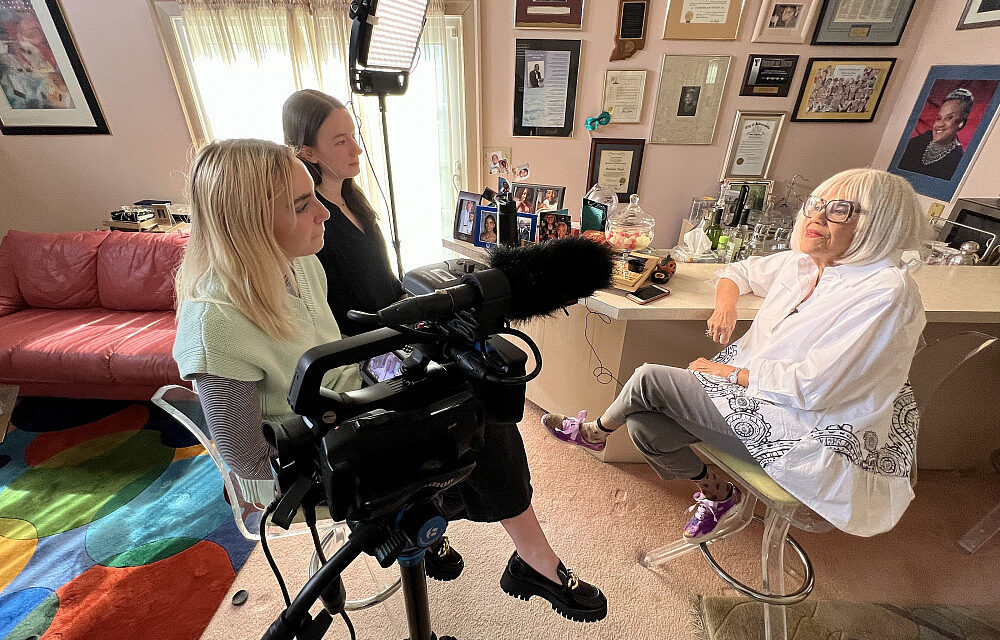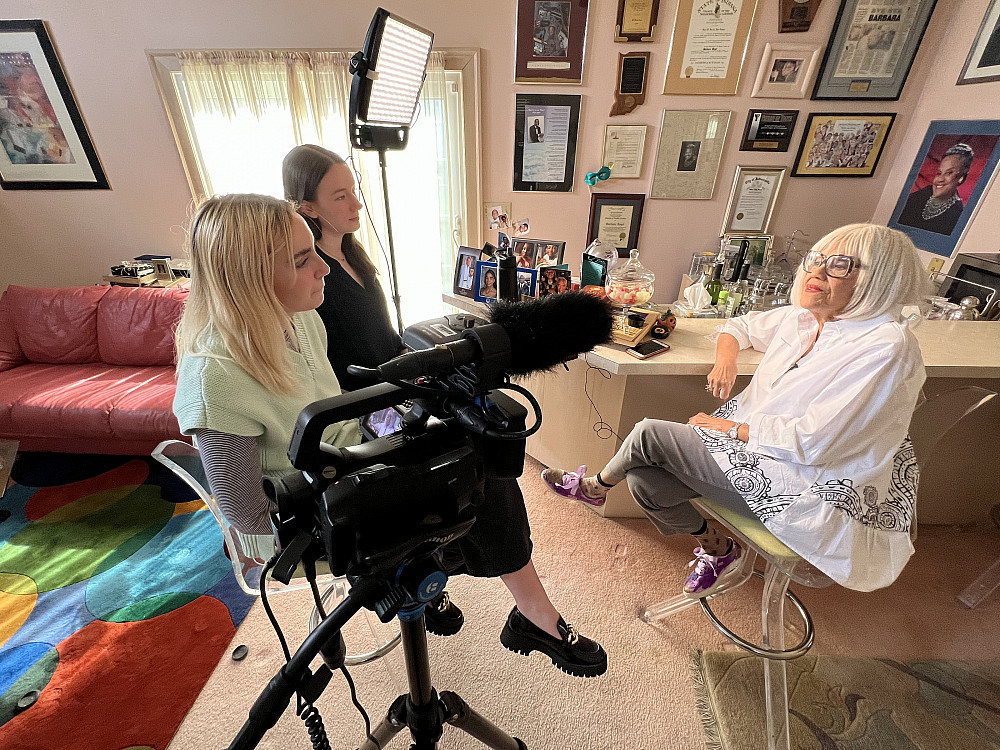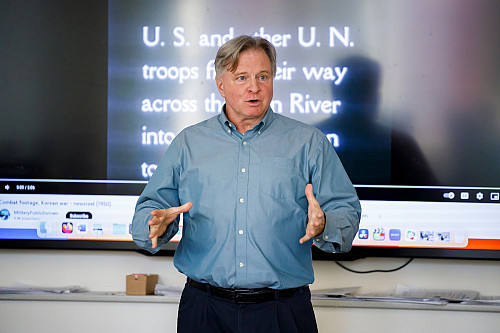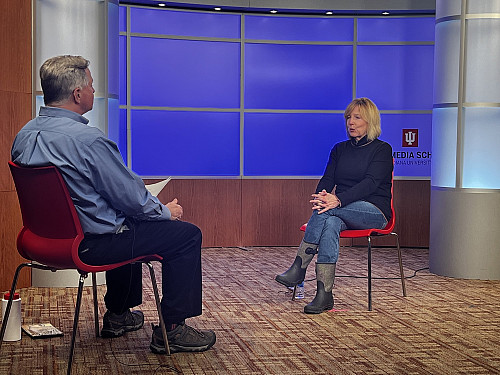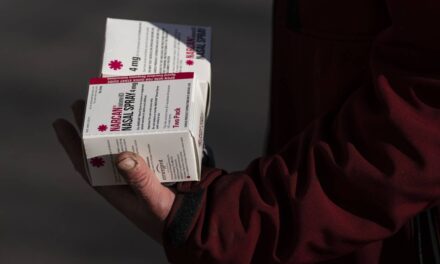For residents of Indiana, names like Howard Caldwell, Ken Beckley, Barbara Boyd and Anne Ryder may ring a bell. They are among the many local broadcasters Hoosiers have welcomed into their living rooms over the years to deliver the day’s news from the warm glow of a television. At Indiana University Bloomington, a professor and an archivist teamed up to preserve Indiana’s history as told by the familiar faces and voices of local radio and television broadcasters.
“It’s the story of our state,” said Mike Conway, professor in The Media School and director of the Indiana Broadcast History Archive. “That’s what we do at The Media School: We tell stories.”
Conway worked in broadcast news for nearly 20 years before becoming a journalism historian, returning to his alma mater as a professor. He was inspired to create the archive because he noticed a lack of preservation for broadcast news in comparison to print news. This archive is the first of its kind.
“You can search The New York Times all the way back to the 1860s, but we don’t know what the local TV or radio station did 10 to 20 years ago because it just wasn’t saved in any systematic way,” Conway said.
Conway joined forces with Josh Bennett, The Media School’s archivist, and they began work on the Indiana Broadcast History Archive four years ago. The duo received a $25,000 grant from the IU Bloomington Public Arts and Humanities Project to kickstart the initiative, with a goal to catalog, collect, preserve and showcase a century of historical material related to the people, events, stations and companies involved in Indiana radio and television news.
According to Conway, situating the archive within IU has been advantageous since the university is known internationally as a leader in the digitization of moving images and audio, with extensive archival resources and facilities. Conway and Bennett ensured their archive would align with IU’s commitment to make archives and collections accessible to the public as a service to the state.
In addition to a traditional archive, they created an interactive, continually growing website where anyone can explore files, including film, video and audio materials that have been digitally preserved. In its next phase, they plan to grow the archive by adding photograph collections and printed materials.
“We think people are going to enjoy it because it’s not just for archivists,” Conway said. “It’s for the general public as well.”
Bennett said that since the news footage they receive is legally owned by the companies that run each station, access to stream broadcasts on the website can be granted to the public via a simple guest account login. Guests are granted access to the footage for limited periods of time in accordance with copyright law, and IU students and faculty have unrestricted access.
Conway invited students taking his History of Journalism course to get involved with the archive, recording broadcasters’ oral histories. The project teaches students about the evolution of broadcast journalism during the past century while also offering them opportunities to conduct extensive interviews with the industry’s veteran leaders.
“Professor Conway’s enthusiasm for this project was the first example I had of how important this effort is,” said Maya Gray, a senior in the History of Journalism class. “He showed us that there is a wealth of history that goes unrecorded, especially in broadcasting.”
Gray, a journalism major, interviewed award-winning news director and executive producer Karen Rariden as part of the oral history project. Rariden’s career spanned multiple decades in Chicago and Indiana markets. She managed the production of morning, afternoon, evening and nightly news and entertainment shows for CBS, ABC, NBC and Fox affiliates.
“My classmates and I have learned so much from the people we have interviewed,” Gray said. “One of the first things you learn as a journalism student is that we are the preservers and recorders of history. We are also watchdogs for the public. Karen Rariden, for example, witnessed history unfolding and played a role in sharing that with people across the country. One of the biggest things I learned from her was that journalism is a field that constantly changes.”
Individuals who have recorded oral histories for the Indiana Broadcast History Archive include:
- Renowned reporter and IU alum Ken Beckley, an Indiana broadcast pioneer who served as one half of the first dual-anchor team alongside Howard Caldwell at WRTV in 1970. Later in his career, he was president and CEO of the Indiana University Alumni Association. He was inducted into the Indiana Broadcast Pioneers Hall of Fame in 2011.
- Barbara Boyd, the first Black woman to report and anchor on TV in Indiana. She joined WFBM, which is now WRTV, in 1969, where she was a consumer reporter. Boyd recognized the importance of informing women about breast cancer, delivering a report on her own mastectomy from the hospital just days after surgery. She was inducted into the Indiana Broadcast Pioneers Hall of Fame in 2005.
- Anne Ryder, who created and produced the series “Hope to Tell” after several years as the lead anchor at WTHR in Indianapolis. She interviewed Mother Teresa in what would become the religious figure’s final interview. She was inducted into the Indiana Broadcast Pioneers Hall of Fame in 2009 and began teaching broadcast journalism at Indiana University Bloomington in 2014.
- Tom Cochrun, who worked in radio and later joined WISH-TV in Indianapolis as a co-host of PM Magazine. He moved to WTHR in 1981 as a documentary producer and investigative reporter, winning a national Emmy for the documentary “Klan.” He later became CEO of a television and content production company that produced documentaries for The Discovery Channel, TLC, Carlton in the UK, NHK in Japan and PBS. He was inducted into the Indiana Broadcast Pioneers Hall of Fame in 2009.
“For Indiana residents, this archive can serve as a source of information to show them what was happening here decades ago, and hearing important broadcasters’ stories from their firsthand perspectives is something we don’t often have access to,” Gray said. “Everyone can learn something from this archive, which is a great impact for it to have.”
Maddie Slepski, a junior in the History of Journalism class, was inspired after her oral history interview with Kevin Rader, former political reporter for WTHR in Indianapolis. Rader shared personal stories with Slepski from his nearly 50-year career reporting local and national political news to residents of central Indiana, including covering all but one national political convention between 1988 and his retirement in 2020. Rader encouraged her to continue pursuing her passion for journalism.
“It got me excited for the future,” Slepski said. “People always say journalism is a dying field. I just don’t believe that for one second because there is always going to be information that needs to be told. It’s not dying; it’s changing.”
In addition to oral histories, the Indiana Broadcast History Archive website provides searchable biographical information on Indiana journalists and digitized broadcasts, often collected from the journalists themselves. Conway said that TV stations generally save some things for their library, but there is no system in place for what gets saved and what gets thrown away. As film, video and digital formats changed over time, stations faced funding issues that hindered storage space, and acquiring the equipment to preserve older formats is expensive.
Much of the footage they have digitized thus far came from former broadcasters’ personal collections, often stored in their basements at home. The first acquisition they made was donated by Ginny Hingst, daughter of the late Howard Caldwell, who was lead anchor for WRTV from the 1960s into the 1990s. Hingst donated much of her father’s collection, including notes, scripts and video footage, which he meticulously preserved himself. Caldwell’s collection is now preserved digitally within the Indiana Broadcast History Archive.
Conway and Bennett are hopeful that as word about the archive spreads, more will get involved.
“This is just the beginning,” Conway said. “With volunteer and financial help, we can grow this archive into a truly statewide effort and tell the stories of the people, stations and events in Indiana broadcast history. IU has provided us funding and tremendous support up to this point. Now we’re hoping the broadcast community and others will see the value and join us in this project.”

